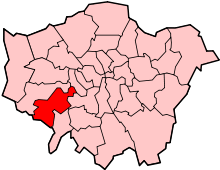Head of the River Fours
| Head of the River Fours | |
|---|---|
| Frequency | Annual |
| Location(s) | Championship Course, River Thames in London, England |
| Years active | 1955–Present |
| Previous event | 30 November 2013 |
| Next event | 2014 |
| Participants | 550 crews |
| Website | |
|
www | |
The Fuller's Head of the River Fours (HOR4s) is a processional rowing race held annually on the Tideway of the River Thames in London on the 4 1⁄4-mile (6.8 km) Championship Course from Mortlake to Putney.
History
The idea for a Tradesmen's Tideway Head Race for fours, was first mooted in the early 1950s by the Thames Amateur Rowing Association (the TARA).[n 1]
On picking a date for the new race the TARA dropped their plans after learning that the Tradesmen's Rowing Clubs Association had also started to organise a similar open fours race.[n 2]
Thus the fledging "Head of the River 4's" was first raced in 1955. In the following years the race was known as the Tradesmen's Rowing Club's Association Head of the River Fours, though even at this stage ARA clubs were entering along with NARA and TRCA clubs.
In the late 1950s the ARA and NARA finally merged into the Amateur Rowing Association of Great Britain. The event then became known simply as the Head of the River Fours, and was handed over to a new Committee in 1963 after the TRCA's eventual amalgamation.
Since that time many changes have taken place to the race, including the course length and alterations. Most crew/boat categories with four rowers have been added. In particular the introduction of quads was in 1969 attracting initially the lowest number of entries in a boat class, three.
A women's junior quadruple sculls event was added in 2005, in 2007, Women's Elite Coxed Fours were scrapped to be replaced with Women's Senior 2 Coxless Fours and the 2008 race added Elite Open Lightweight and Elite Women's Lightweight quads for the first time.
In the first race, 34 crews rowed over a three-mile course from Chiswick Steps to Putney Pier. The entry has grown steadily over the years and in 1990 the race was extended to the full four and a quarter mile Championship Course from Mortlake to Putney (i.e., the Oxford and Cambridge Boat Race course in reverse).
For many years the entry exceeded the 500 permitted maximum, but in 1997 the Port of London Authority agreed to a request for 50 more crews. Even with 550 places available (the largest number of crews entered in a one race in the UK) the race is still heavily oversubscribed.
Fuller, Smith and Turner began their sponsorship of the Race in 1979 and event winners are rewarded each year with excellent hospitality in the Hock Cellar at the Griffin Brewery in Chiswick, where the prizes are presented.
Events
The current breakdown of events of offer is:
Quadruple sculls (4x) (Nine Events) Open Elite; Women's Elite; Open Elite Lwt; Women's Elite Lwt; Open Senior 1; Open Senior 2; Women's Senior 2; Open Junior; Women's junior
Coxless fours (4-) (Five Events) Open Elite; Women's Elite; Open Senior 1; Open Senior 2; Women's Senior 2
Coxed fours (4+) (Eight Events) Open Elite; Open Senior 1; Open Senior 2; Women's Senior 2; Open Senior 3 (Club and Academic), Women's Senior 3 (Club and Academic)
See also
- Rowing on the River Thames
- Head of the River Race – a similar race open to men's eights.
- Women's Eights Head of the River Race
Notes and references
- Notes
- ↑ This was the Thames branch of the National Amateur Rowing Association, the governing body formed of manual workers who could not join the ARA (which did not recognise their amateur status, maintaining until the late 1960s in some international events that rowing was a good sport for non-manual workers but that they could be put at a disadvantage if racing against those who worked outdoors in physically demanding work.) NARA's existence reflected demand from such men and women too to compete in the sport, many of whom were drawn to the sport by living near a busy river.
- ↑ A similar organisation formed of riverine and canal-based professionals such as hired watermen, point-to-point ferrymen, bargemen and boat repairers and all others who worked with boats full-time.
- References
- Cleaver, Hylton, A History of Rowing
- National Amateur Rowing Association, London Metropolitan Archives, Catalogue Ref. A/NAR
